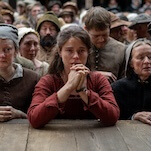Instead, the filmmakers spend a great deal of time on standard commentary-track chat: the percentage of CGI vs. live-action footage in various shots and sequences, the order shots were taken, the symbolic meaning of various story developments or costume choices, and so forth. They discuss their admiration for Edgar Rice Burroughs’ John Carter novels, and the goal of making a timeless film that evokes those timeless books, then congratulate themselves on having nailed it. They sometimes talk like the film was an exhausting grind, and sometimes like it was a party—particularly during the scenes shot on a river, because sailing to work is fun, even when all the bathrooms are a 20-minute boat ride away. Morris says it was the biggest film any of them had worked on, but that just kept them from worrying too much: “I think our naïveté helped us get through a lot of stuff that probably would have crushed many people.”
They also chat a good bit about shooting in Utah, at one point sharing a valley with “a dinosaur excavation,” a group of researchers testing Mars Rover designs, and another living in pods to simulate astronauts in a Mars base camp. “But we were the ones doing God’s work,” Collins jokes.
What went wrong: Given the $250 million production budget, the filmmakers have no recourse to two of the three most common filmmaker complaints: lack of time and lack of money. In fact, they repeatedly chuckle over some of their expensive choices, like having a bridge built to get the cast and crew to a remote area, or keeping a huge team of Italian shoemakers on hand just to churn out boots. At one point, Stanton says that halfway through the shoot, he realized that on a production this big, everyone had to be ready at every moment for anything the director demanded, so he got “drunk with power” and abruptly demanded a couple of chickens for a scene he was shooting. They arrived within 15 minutes. He and Collins describe his reaction as, “I want a pony!” “I want a cow, and a monkey! I want it now!… I want chickens and a pony and a bridge that takes me from the highway to that cliff!”
A further sign money was no object: Stanton shot on film simply because he felt like it. “I just wanted to know what it was like. I’ve spent so much of my life as a fan watching other kids play, I wanted to know what was it like to play like that.” And in spite of the expensive medium, he was able to keep three cameras running at all times to “keep my [editing] options open and be a little more intuitive on the day.”
That largely just leaves the third common complaint: the weather. Conditions on the Utah locations that stood in for Mars ranged from 20 degrees on the one overnight shoot (with “everyone else shivering in parkas” while Kitsch spent the whole night jumping around in a loincloth) to 111 degrees in the shade, with frequent dust storms. Also, for the last scene shot in England, they could only shoot “every eight minutes or so” because of the noise from nearby Heathrow Airport. Even once that quieted down, a memorial service for a dead bell-ringer kept cathedral bells in the area going for at least half an hour during shooting.
Also, after a test screening months before release, the crew went back to shoot a scene where [spoiler!] Kitsch proposes to Lynn Collins after breaking up her incipient forced marriage to villain Dominic West and taking West’s place at the altar. Collins: “One of the big notes was ‘Ahhh, we just want to see him propose, we want to see him declare his love.’ We want to hear it.” Stanton: “Being a guy, that just totally shot past me. I thought I was being a smart, economical filmmaker. ‘We all know what he wants, and then we just cut to the actual ceremony.’” Collins: “And every woman in the audience is like ‘Noooo! He must propose!’” Stanton: “Which explains why when I proposed to my wife, it was such an uneventful moment… Screwed it up big-time.”
Comments on the cast: Stanton and company praise many people at length, particularly the designers, the AD, and Kitsch, whom Stanton describes as “the Bob Hoskins of the new millennium” for his ability to use “unconscious muscle memory” to reproduce his physical performance accurately from shot to shot, as Hoskins did in Who Framed Roger Rabbit. Stanton also loved Kitsch’s blankness: “Even compared with some of his peers around the same age who had done a few more films, you had the ability to kind of sculpt him like fresh clay. He didn’t come with an other personality attached to him; you could kind of make him John Carter.” Collins, meanwhile, loved how he was “kind of the bad boy who every woman is rooting for.”
Inevitable dash of pretension: During a cartoonish, over-the-top sequence where Kitsch flashes back to his dead family on Earth and single-handedly slaughters dozens of savage Warhoon-tribe Martians, the filmmakers swoon over how the sequence is, alternately, a lyrical poem or “one organic dance number… When you left that scene, I wanted you to feel like you had fought the past, you hadn’t fought the Warhoons. And that was always the goal: fought the emotions, the cathartic experience of what he was fighting. And it did that… Sort of the gate he had to get past to move forward.”
Stanton also talks at length about how directing requires snap aesthetic judgments based on uncontrollable conditions; he cites a quote from Akira Kurosawa, telling Martin Scorsese that a particular shot Scorsese loved in Rashomon was shot that way because, “If I panned to the left, there was a hospital, and if I panned to the right, there was a highway.” Stanton: “You go in expecting unforeseen obstacles and limitations to come your way, and part of the thrill is, ‘How do we use it? How do we get around it, or embrace it?’” In his case, he got around the rainy, cold shooting conditions in England for John Carter’s Earth-based scenes via the “thematically smart” choice to make the Earth scenes rainy, cold, and blue, to contrast arid, hot, red Mars. “I would have loved to have made that decision without coming to it that way, but if that’s what it takes, it’s fine. Those kinds of things, as they come together, make you feel like you’re headed in the right direction. Like the movie kind of pre-exists, and it’s telling you what it wants to be.”
Commentary in a nutshell: Stanton, on the casting choices available to a man helming a $250 million movie: “I was always pinching myself… We basically got anyone we would have ever wanted to work with.”







































